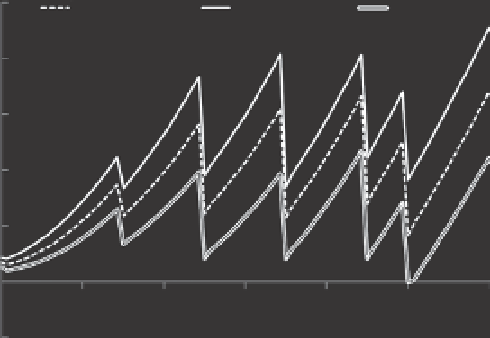Agriculture Reference
In-Depth Information
outputs (e.g. feed cost). It is recommended
that the pre-deined objective remains rea-
sonable and achievable. Iterative processes
of improvement usually represent the most
appropriate means of attaining the pre-
determined objective with no negative im-
pact on other outputs. In the present sec-
tion an example is taken where we consider
that reducing feed cost by US$0.03/kg of
live weight is the pre-deined objective for
6 kg live weight mixed medium turkeys.
affect performance (e.g. feed conversion
ratio (FCR)). To quantify the outcomes of al-
ternative solutions 'what-if' simulations may
be run to examine the effect of reducing the
amino acid levels on weight gain and feed
conversion, and thus on feed cost (i.e. three
Validation of model alternatives
Although turkey research studies take sev-
eral months before completion, validating
the model alternatives is recommended
before implementing new recommenda-
tions. The research trial should consist of a
control diet that corresponds to the refer-
ence programme, while the other alternative
diets constitute the test treatments. Model
simulations can therefore be directly com-
pared to the trial results. In
Fig. 8.5
the
model simulations are compared to obser-
vations from a research trial in which dif-
ferent levels of metabolizable energy were
tested. While accuracy was moderate (i.e. 10%
difference) relative model precision was
satisfactory when predicting average daily
gain at 49 days and 105 days of age at energy
levels varying from 92% to 108% of stand-
ard levels (i.e. constant amino acid levels).
As mentioned above, random error may
result in differences between simulated and
Description of present situation
and alternatives for improvement
The adjustment of user-defined parameters
makes it possible to represent the present situ-
ation. The user-defined parameters refer to
parameters that define the genetic potential,
the environmental conditions and the feed
programme (feed sequence and nutrient pro-
file). Adjustments may be performed either
manually or through an optimization proced-
ure. Based on the designed situation/simulation
the user is capable of evaluating opportunities
for improvement through 'what-if' scenarios
that explore alternative strategies to reach the
pre-defined objective.
In the example above, an alternative to
reducing feed cost may be to decrease nutri-
ent levels, although this may negatively
1
Tr eatment 1
Treatment 2
Treatment
3
0.8
0.6
0.4
0.2
0
0
1
4
2
8
42
56
70
84
-0.2
Age (days)
Fig. 8.4.
Simulation of excess lysine depending on three commercial feed programmes that vary in dietary
amino acid density.

